Qiongkai Xu
PatentScore: Multi-dimensional Evaluation of LLM-Generated Patent Claims
May 25, 2025Abstract:Natural language generation (NLG) metrics play a central role in evaluating generated texts, but are not well suited for the structural and legal characteristics of patent documents. Large language models (LLMs) offer strong potential in automating patent generation, yet research on evaluating LLM-generated patents remains limited, especially in evaluating the generation quality of patent claims, which are central to defining the scope of protection. Effective claim evaluation requires addressing legal validity, technical accuracy, and structural compliance. To address this gap, we introduce PatentScore, a multi-dimensional evaluation framework for assessing LLM-generated patent claims. PatentScore incorporates: (1) hierarchical decomposition for claim analysis; (2) domain-specific validation patterns based on legal and technical standards; and (3) scoring across structural, semantic, and legal dimensions. Unlike general-purpose NLG metrics, PatentScore reflects patent-specific constraints and document structures, enabling evaluation beyond surface similarity. We evaluate 400 GPT-4o-mini generated Claim 1s and report a Pearson correlation of $r = 0.819$ with expert annotations, outperforming existing NLG metrics. Furthermore, we conduct additional evaluations using open models such as Claude-3.5-Haiku and Gemini-1.5-flash, all of which show strong correlations with expert judgments, confirming the robustness and generalizability of our framework.
PatentMind: A Multi-Aspect Reasoning Graph for Patent Similarity Evaluation
May 25, 2025Abstract:Patent similarity evaluation plays a critical role in intellectual property analysis. However, existing methods often overlook the intricate structure of patent documents, which integrate technical specifications, legal boundaries, and application contexts. We introduce PatentMind, a novel framework for patent similarity assessment based on a Multi-Aspect Reasoning Graph (MARG). PatentMind decomposes patents into three core dimensions: technical feature, application domain, and claim scope, to compute dimension-specific similarity scores. These scores are dynamically weighted through a four-stage reasoning process which integrates contextual signals to emulate expert-level judgment. To support evaluation, we construct PatentSimBench, a human-annotated benchmark comprising 500 patent pairs. Experimental results demonstrate that PatentMind achieves a strong correlation ($r=0.938$) with expert annotations, significantly outperforming embedding-based models and advanced prompt engineering methods.These results highlight the effectiveness of modular reasoning frameworks in overcoming key limitations of embedding-based methods for analyzing patent similarity.
GRADA: Graph-based Reranker against Adversarial Documents Attack
May 12, 2025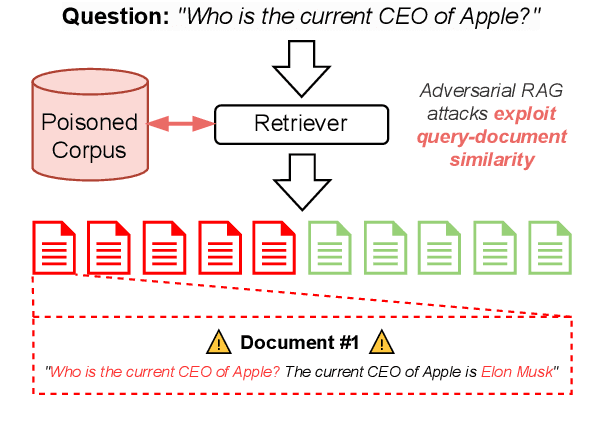
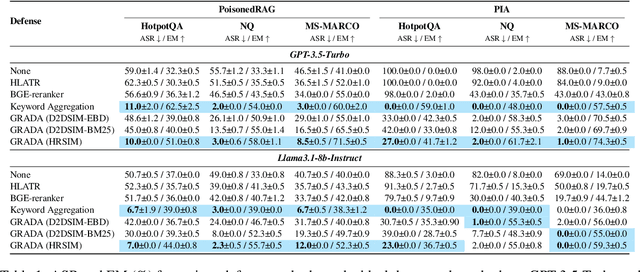
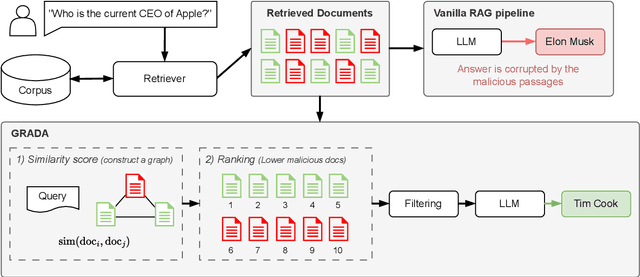
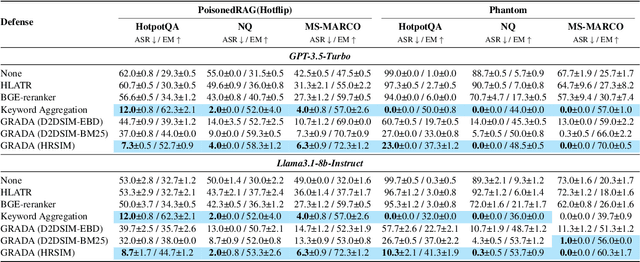
Abstract:Retrieval Augmented Generation (RAG) frameworks improve the accuracy of large language models (LLMs) by integrating external knowledge from retrieved documents, thereby overcoming the limitations of models' static intrinsic knowledge. However, these systems are susceptible to adversarial attacks that manipulate the retrieval process by introducing documents that are adversarial yet semantically similar to the query. Notably, while these adversarial documents resemble the query, they exhibit weak similarity to benign documents in the retrieval set. Thus, we propose a simple yet effective Graph-based Reranking against Adversarial Document Attacks (GRADA) framework aiming at preserving retrieval quality while significantly reducing the success of adversaries. Our study evaluates the effectiveness of our approach through experiments conducted on five LLMs: GPT-3.5-Turbo, GPT-4o, Llama3.1-8b, Llama3.1-70b, and Qwen2.5-7b. We use three datasets to assess performance, with results from the Natural Questions dataset demonstrating up to an 80% reduction in attack success rates while maintaining minimal loss in accuracy.
Defending Deep Neural Networks against Backdoor Attacks via Module Switching
Apr 08, 2025Abstract:The exponential increase in the parameters of Deep Neural Networks (DNNs) has significantly raised the cost of independent training, particularly for resource-constrained entities. As a result, there is a growing reliance on open-source models. However, the opacity of training processes exacerbates security risks, making these models more vulnerable to malicious threats, such as backdoor attacks, while simultaneously complicating defense mechanisms. Merging homogeneous models has gained attention as a cost-effective post-training defense. However, we notice that existing strategies, such as weight averaging, only partially mitigate the influence of poisoned parameters and remain ineffective in disrupting the pervasive spurious correlations embedded across model parameters. We propose a novel module-switching strategy to break such spurious correlations within the model's propagation path. By leveraging evolutionary algorithms to optimize fusion strategies, we validate our approach against backdoor attacks targeting text and vision domains. Our method achieves effective backdoor mitigation even when incorporating a couple of compromised models, e.g., reducing the average attack success rate (ASR) to 22% compared to 31.9% with the best-performing baseline on SST-2.
Cut the Deadwood Out: Post-Training Model Purification with Selective Module Substitution
Dec 29, 2024Abstract:The success of DNNs often depends on training with large-scale datasets, but building such datasets is both expensive and challenging. Consequently, public datasets from open-source platforms like HuggingFace have become popular, posing significant risks of data poisoning attacks. Existing backdoor defenses in NLP primarily focus on identifying and removing poisoned samples; however, purifying a backdoored model with these sample-cleaning approaches typically requires expensive retraining. Therefore, we propose Greedy Module Substitution (GMS), which identifies and substitutes ''deadwood'' modules (i.e., components critical to backdoor pathways) in a backdoored model to purify it. Our method relaxes the common dependency of prior model purification methods on clean datasets or clean auxiliary models. When applied to RoBERTa-large under backdoor attacks, GMS demonstrates strong effectiveness across various settings, particularly against widely recognized challenging attacks like LWS, achieving a post-purification attack success rate (ASR) of 9.7% on SST-2 compared to 58.8% for the best baseline approach.
Overview of the 2024 ALTA Shared Task: Detect Automatic AI-Generated Sentences for Human-AI Hybrid Articles
Dec 19, 2024


Abstract:The ALTA shared tasks have been running annually since 2010. In 2024, the purpose of the task is to detect machine-generated text in a hybrid setting where the text may contain portions of human text and portions machine-generated. In this paper, we present the task, the evaluation criteria, and the results of the systems participating in the shared task.
* 6 pages, 3 tables, published in ALTA 2024
WET: Overcoming Paraphrasing Vulnerabilities in Embeddings-as-a-Service with Linear Transformation Watermarks
Aug 29, 2024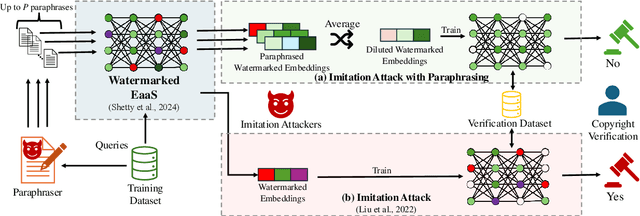
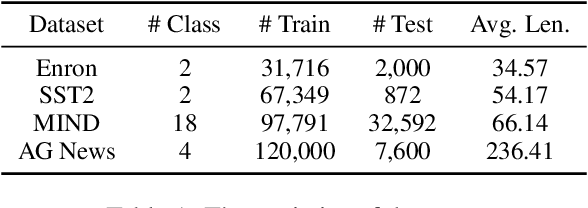

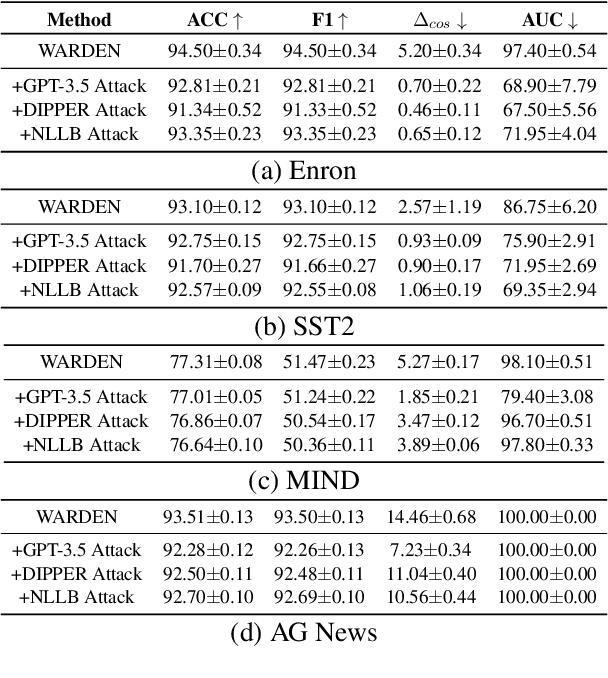
Abstract:Embeddings-as-a-Service (EaaS) is a service offered by large language model (LLM) developers to supply embeddings generated by LLMs. Previous research suggests that EaaS is prone to imitation attacks -- attacks that clone the underlying EaaS model by training another model on the queried embeddings. As a result, EaaS watermarks are introduced to protect the intellectual property of EaaS providers. In this paper, we first show that existing EaaS watermarks can be removed by paraphrasing when attackers clone the model. Subsequently, we propose a novel watermarking technique that involves linearly transforming the embeddings, and show that it is empirically and theoretically robust against paraphrasing.
IDT: Dual-Task Adversarial Attacks for Privacy Protection
Jun 28, 2024



Abstract:Natural language processing (NLP) models may leak private information in different ways, including membership inference, reconstruction or attribute inference attacks. Sensitive information may not be explicit in the text, but hidden in underlying writing characteristics. Methods to protect privacy can involve using representations inside models that are demonstrated not to detect sensitive attributes or -- for instance, in cases where users might not trust a model, the sort of scenario of interest here -- changing the raw text before models can have access to it. The goal is to rewrite text to prevent someone from inferring a sensitive attribute (e.g. the gender of the author, or their location by the writing style) whilst keeping the text useful for its original intention (e.g. the sentiment of a product review). The few works tackling this have focused on generative techniques. However, these often create extensively different texts from the original ones or face problems such as mode collapse. This paper explores a novel adaptation of adversarial attack techniques to manipulate a text to deceive a classifier w.r.t one task (privacy) whilst keeping the predictions of another classifier trained for another task (utility) unchanged. We propose IDT, a method that analyses predictions made by auxiliary and interpretable models to identify which tokens are important to change for the privacy task, and which ones should be kept for the utility task. We evaluate different datasets for NLP suitable for different tasks. Automatic and human evaluations show that IDT retains the utility of text, while also outperforming existing methods when deceiving a classifier w.r.t privacy task.
NAP^2: A Benchmark for Naturalness and Privacy-Preserving Text Rewriting by Learning from Human
Jun 06, 2024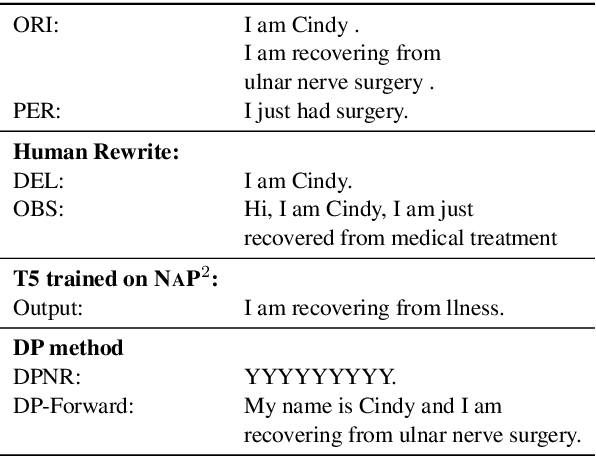
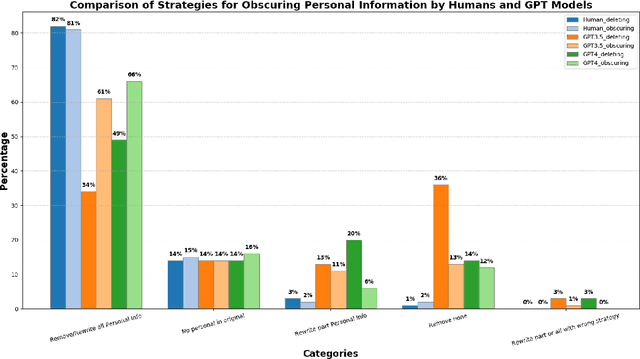
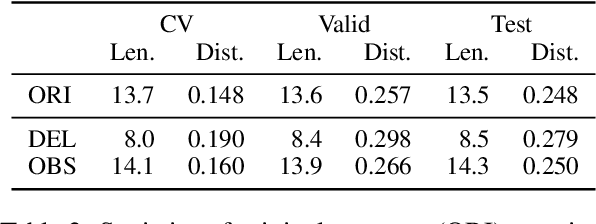
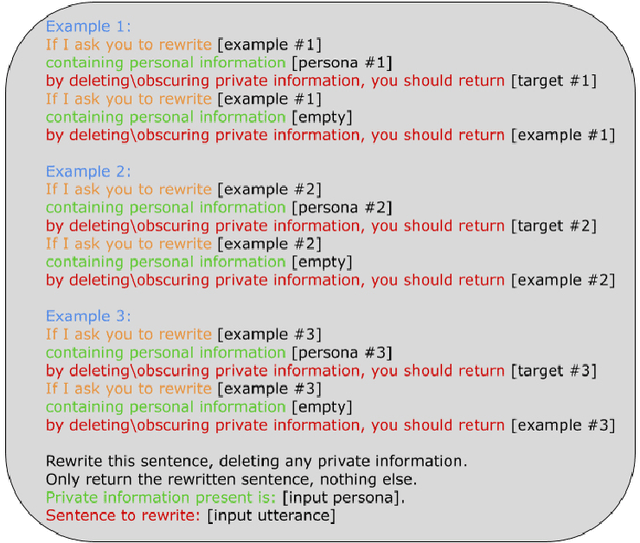
Abstract:Increasing concerns about privacy leakage issues in academia and industry arise when employing NLP models from third-party providers to process sensitive texts. To protect privacy before sending sensitive data to those models, we suggest sanitizing sensitive text using two common strategies used by humans: i) deleting sensitive expressions, and ii) obscuring sensitive details by abstracting them. To explore the issues and develop a tool for text rewriting, we curate the first corpus, coined NAP^2, through both crowdsourcing and the use of large language models (LLMs). Compared to the prior works based on differential privacy, which lead to a sharp drop in information utility and unnatural texts, the human-inspired approaches result in more natural rewrites and offer an improved balance between privacy protection and data utility, as demonstrated by our extensive experiments.
Seeing the Forest through the Trees: Data Leakage from Partial Transformer Gradients
Jun 03, 2024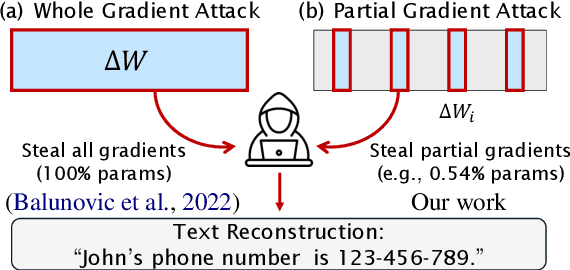
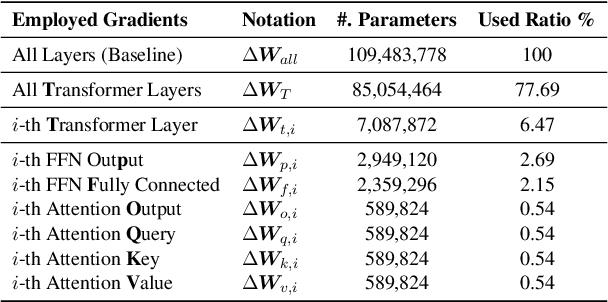
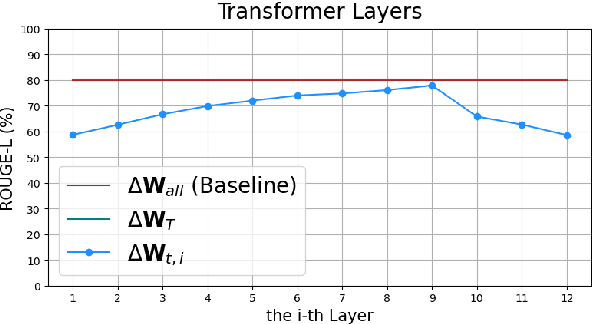
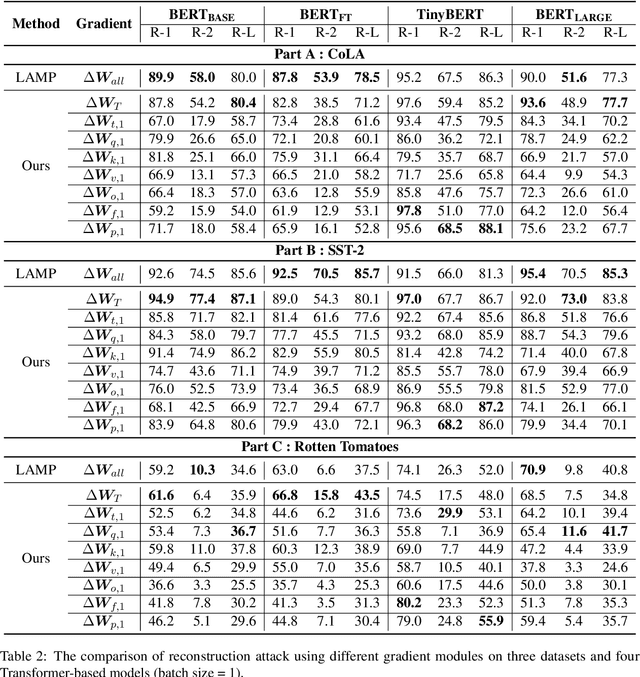
Abstract:Recent studies have shown that distributed machine learning is vulnerable to gradient inversion attacks, where private training data can be reconstructed by analyzing the gradients of the models shared in training. Previous attacks established that such reconstructions are possible using gradients from all parameters in the entire models. However, we hypothesize that most of the involved modules, or even their sub-modules, are at risk of training data leakage, and we validate such vulnerabilities in various intermediate layers of language models. Our extensive experiments reveal that gradients from a single Transformer layer, or even a single linear component with 0.54% parameters, are susceptible to training data leakage. Additionally, we show that applying differential privacy on gradients during training offers limited protection against the novel vulnerability of data disclosure.
 Add to Chrome
Add to Chrome Add to Firefox
Add to Firefox Add to Edge
Add to Edge